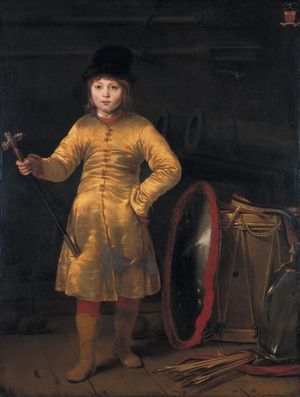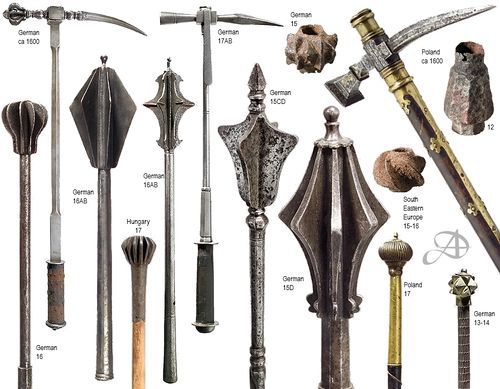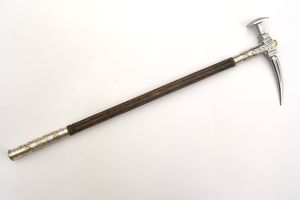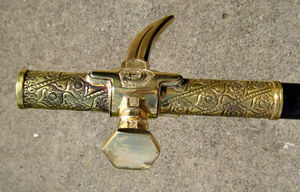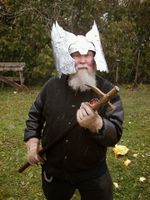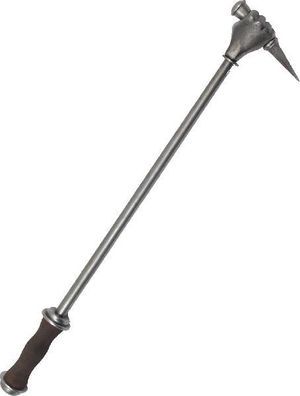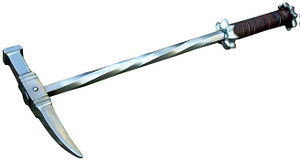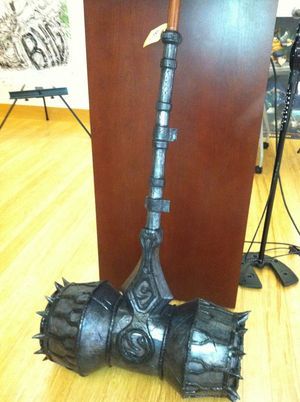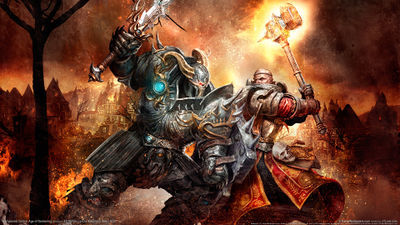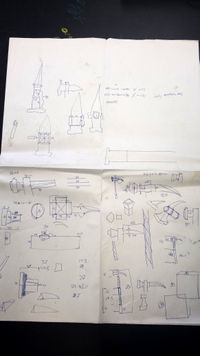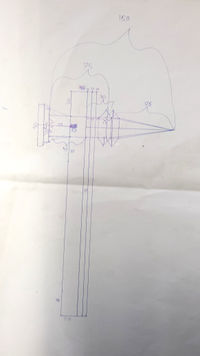Difference between revisions of "Fantastic Forgeries"
H.van.Beek (talk | contribs) |
H.van.Beek (talk | contribs) |
||
| Line 19: | Line 19: | ||
While watching the painting for a while the weapon the boy wielded got my attention. I always liked weapons because of their energy. They cause fear and happiness, hope but mostly death and their cheer presence changed history uncountable times. Old weapons fascinate me because they are so brutal and gruesome. You needed to be up close and personal to be effective. We always see them rusting behind glass or in pictures but recent events in the middle east reminded the world about the practical use of the object. I knew I had to pick an object with such a history and energy, so I'm going to make OTTO'S HAMMER. | While watching the painting for a while the weapon the boy wielded got my attention. I always liked weapons because of their energy. They cause fear and happiness, hope but mostly death and their cheer presence changed history uncountable times. Old weapons fascinate me because they are so brutal and gruesome. You needed to be up close and personal to be effective. We always see them rusting behind glass or in pictures but recent events in the middle east reminded the world about the practical use of the object. I knew I had to pick an object with such a history and energy, so I'm going to make OTTO'S HAMMER. | ||
| − | + | ===OBJECT=== | |
The object itself is a War or Battle hammer. A war hammer is a late medieval weapon of war intended for close combat action, whose design resembles the hammer. Its appearance is similar to that of an ice axe. It was an anti-armour weapon, with a hammer for maximum damage and a spike for armour penetration. It was especially used in Poland, Germany and other Slavic and Scandinavian countries. This particular shape is called the Nadziak, which is Polish name for the weapon. | The object itself is a War or Battle hammer. A war hammer is a late medieval weapon of war intended for close combat action, whose design resembles the hammer. Its appearance is similar to that of an ice axe. It was an anti-armour weapon, with a hammer for maximum damage and a spike for armour penetration. It was especially used in Poland, Germany and other Slavic and Scandinavian countries. This particular shape is called the Nadziak, which is Polish name for the weapon. | ||
| Line 25: | Line 25: | ||
[[File:Strijdhamers.jpg | 500px]] | [[File:Strijdhamers.jpg | 500px]] | ||
| − | + | ===VERSIONS=== | |
The weapon is a brass head on a wooden handle with a brass cover on the bottom. This is a classical Polish shape which is in the painting. These weapons are modern reproductions, versions of the original weapon. They have the same shape and size. | The weapon is a brass head on a wooden handle with a brass cover on the bottom. This is a classical Polish shape which is in the painting. These weapons are modern reproductions, versions of the original weapon. They have the same shape and size. | ||
| Line 43: | Line 43: | ||
So for the reproduction I would like to make a War hammer like the one from the painting but with contemporary technologies. Using welding bandsaws and all the modern technologies to make the deadly weapon from the 1600. My mission for the reproduction was: surprise the metalworker. If I make a hammer with my limited knowledge of metalworking I would never achieve the same detail like a professional metalworker would. But with my skil as a creator I would surprise the metalworker with a technique where he would never have thought of. | So for the reproduction I would like to make a War hammer like the one from the painting but with contemporary technologies. Using welding bandsaws and all the modern technologies to make the deadly weapon from the 1600. My mission for the reproduction was: surprise the metalworker. If I make a hammer with my limited knowledge of metalworking I would never achieve the same detail like a professional metalworker would. But with my skil as a creator I would surprise the metalworker with a technique where he would never have thought of. | ||
| − | + | ===Edit1:=== | |
After being in the workshop I drew my ideas and blue prints and figure out how to use what material where: | After being in the workshop I drew my ideas and blue prints and figure out how to use what material where: | ||
| Line 49: | Line 49: | ||
| − | [[File:20141001 145154 copy.jpg | | + | [[File:20141001 145154 copy.jpg | 200px]][[File:20141001 145125.jpg | 200px]] |
==RESEARCH== | ==RESEARCH== | ||
Revision as of 13:55, 1 October 2014
Authourship & Authenticity Project: Museum Of Fantastic Forgeries
- A (scaled) replica of your chosen artefact from the Boijmans collection using a different medium than the original
- A well-crafted contemporary transformation based on your chosen object of the Boijmans collection
- A document and blueprint for the remaking of your original and transformed artefacts
- A 1000 word statement defining your position of where your specific 'craft' lies in relation newer technologies
- A visualisation and oral presentation of your research based of mapping/iteration/storytelling assignments.
OTTO'S HAMMER
In the introduction assignment Make from the Museum we did some scouting in the Boijmans. In that introduction my eye fell on a work from Ferdinand Bol.
The under-script was: This painting shows a boy in Polish costume holding a war hammer. On the floor are a shield, a drum, a 'cuirass' or armoured breastplate and a bow and quiver of arrows. In the background are two cannons with accompanying ramrods and wiper. The boy is Otto van der Waeyen, the son of an Amsterdam based weapons trader who had contacts with Poland.
At first I only saw the letters and the words, just like all the other descriptions of all the work in the Boijmans. But then it came to me. The Netherlands was in the Golden Age, a wealthy time glorified by the Dutch people today. But the wealth has been gathered was gain due to piracy, slavery, bribery, war and especially death. That is was I remember from the history-lessons. In the year 1656, a Dutch weapon trader earned enough from the war in Poland with Russia to let his son with a weapon and his merchandise get painted by a master painter. I learned a lesion about how time changes perspectives right there.
While watching the painting for a while the weapon the boy wielded got my attention. I always liked weapons because of their energy. They cause fear and happiness, hope but mostly death and their cheer presence changed history uncountable times. Old weapons fascinate me because they are so brutal and gruesome. You needed to be up close and personal to be effective. We always see them rusting behind glass or in pictures but recent events in the middle east reminded the world about the practical use of the object. I knew I had to pick an object with such a history and energy, so I'm going to make OTTO'S HAMMER.
OBJECT
The object itself is a War or Battle hammer. A war hammer is a late medieval weapon of war intended for close combat action, whose design resembles the hammer. Its appearance is similar to that of an ice axe. It was an anti-armour weapon, with a hammer for maximum damage and a spike for armour penetration. It was especially used in Poland, Germany and other Slavic and Scandinavian countries. This particular shape is called the Nadziak, which is Polish name for the weapon.
VERSIONS
The weapon is a brass head on a wooden handle with a brass cover on the bottom. This is a classical Polish shape which is in the painting. These weapons are modern reproductions, versions of the original weapon. They have the same shape and size.
These days people make medieval weapons for films, re-enactments, renascence fairs etc. So forging, casting and fetching are sill crafts used today to create weapons. Some weapons are ridiculously over-designed, and some are just modernised. For these purposes people make swords most of the time make swords because they are the signature weapon for medieval times. But there are examples of hammers.
When searching for medieval weapons made in modern times you cannot skip the existence of Life Action Role Playing Games. Where people pick up the foam sword and impersonate a fictional character for a weekend. Also when googleing for a Warhammer you will come across a fantasy world magnificently called Warhammer. It is a Tabletop-game from the manufacturer Games Workshop. Its is a world with massive story. Though the link with fantasy exists I do not want to use it. Weapons in fantasy are most of the time over designed and exaggerated. While one of the most interesting parts of Otto's Hammer is that its simple but effective.
REPRODUCTION
So for the reproduction I would like to make a War hammer like the one from the painting but with contemporary technologies. Using welding bandsaws and all the modern technologies to make the deadly weapon from the 1600. My mission for the reproduction was: surprise the metalworker. If I make a hammer with my limited knowledge of metalworking I would never achieve the same detail like a professional metalworker would. But with my skil as a creator I would surprise the metalworker with a technique where he would never have thought of.
Edit1:
After being in the workshop I drew my ideas and blue prints and figure out how to use what material where:
